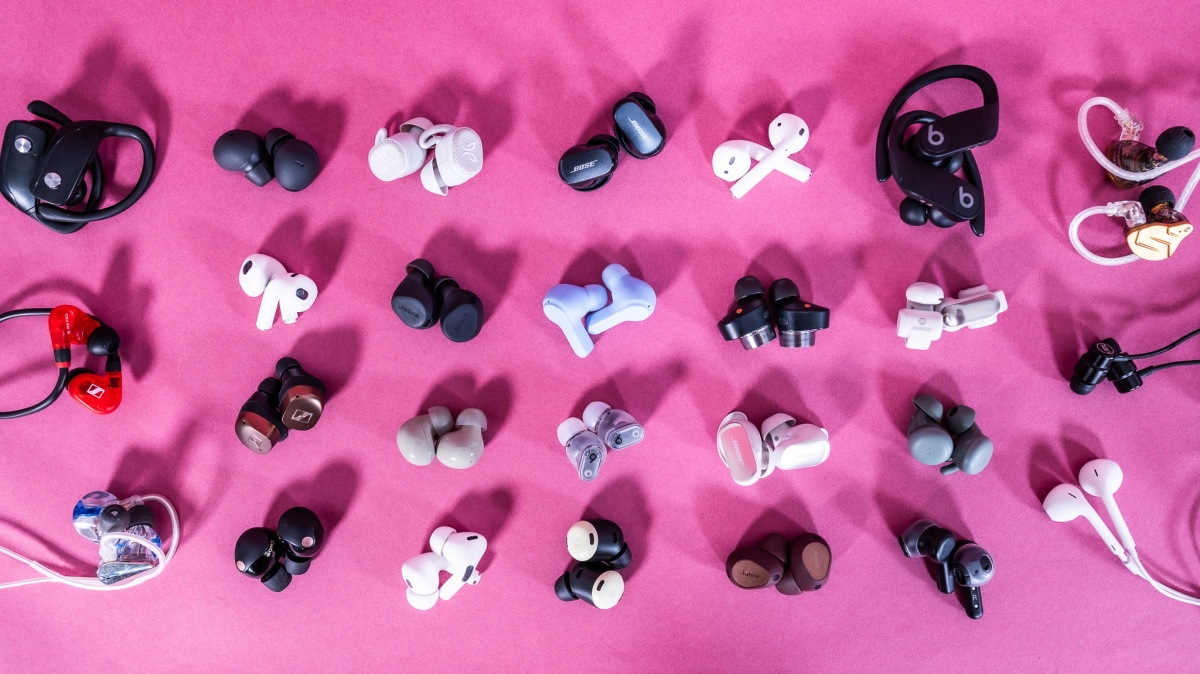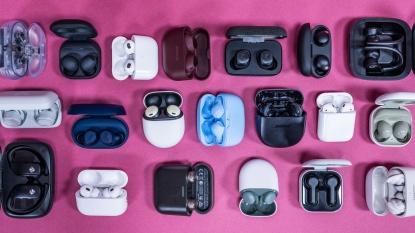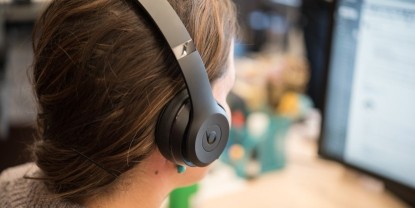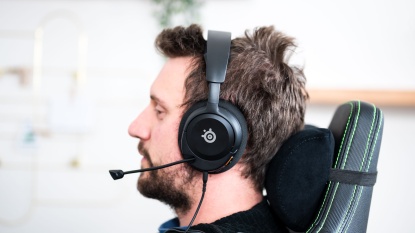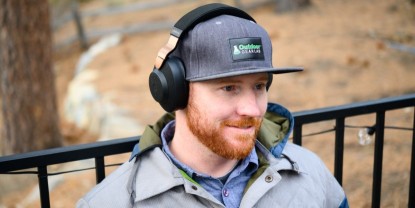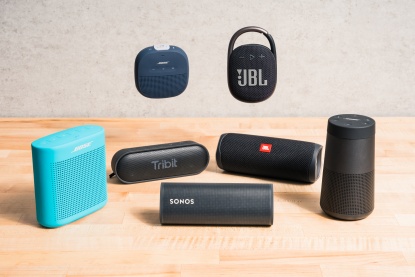Why You Want Noise Cancelling
Sounds are vibrations that travel through the air in waves. When multiple sound waves overlap, they can obscure or amplify one another. It's called auditory masking, and it's why you might feel the urge to crank up the volume when you're listening to your favorite music in loud environments. That, friends, is bad for your ears.
One way to avoid blasting out your eardrums is to buy a pair of noise cancelling headphones. Since they can block background noise that interferes with your music, show, or podcast, you can keep the volume at safer levels. Conventional wisdom is that it should stay at or below 70 decibels, or roughly the sound of a casual conversation. Noise cancelling headphones (NCHs) also help you hear the nuances of every note, making your favorite music sound the way it's meant to be heard.
Keeping your ears healthy and creating an ideal listening environment aren't the only benefits of noise cancelling technology. For people who are easily stressed out by noisy environments, like an airplane in flight, they can also offer a calming effect. Some workers find that noise cancelling headphones or earbuds calm the mind and increase focus during and after the workday, as Digital Trends reports. (Many of our staffers heartily agree.) The article cites a 2016 study that NCHs can help autistic children deal with stressful sounds and another indicating that they reduce the pain and anxiety of patients undergoing a painful procedure.
In this article, we'll explain noise cancelling technology and help you understand the key factors to consider when choosing the right pair of earbuds or over-the-ear headphones for your needs.
How Sound Works
A waveform is a graph that charts time on the horizontal x-axis and amplitude on the vertical y-axis. Amplitude is measured in hertz (Hz), or the number of sound waves that pass by in a second. We use waveforms to visualize sound waves. The height (amplitude) and length (frequency) of those waves impact how our ears interpret them.
Taller waves have more amplitude, or more space between the height of the peak and the depth of the trough, and sound louder. Longer waves have lower frequencies (i.e., they roll in less frequently) and register as bass notes. Short, high-frequency waves, register as high-pitched treble notes.
When multiple sound waves share space, the sound you will hear depends on how the peaks and valleys of each waveform align and combine — a process known as additive synthesis.
If the peaks of two sound waves align, they will combine and grow taller and louder. For example, if both peaks have an amplitude of 1 Hz, they will sound twice as loud. Sound waves that peak at the same time and have the same frequency have the same phase. If the peak of one wave aligns with the trough of another, they are out of phase by 180 degrees. In that case, the +1 of the peak and the -1 of the trough combine to equal zero.
How Noise Cancelling Works
Noise cancelling headphones and earbuds have microphones that record ambient sounds around you. Then, an internal processor creates the inverse sound wave, one that is 180 degrees out of phase, and plays it through the speakers alongside your music or show. Viola, the external noise is canceled, mostly. In reality, it's often just minimized. We'll dive into the details so you can understand the subtleties and help you decide the type of noise cancelling you need.
Two elements dampen external sounds when using earbuds or headphones — active noise cancellation and passive isolation. The process discussed above is active noise cancellation. Passive noise isolation means physically blocking sound waves. All headphones and earbuds accomplish this to an extent simply because they create a barrier between your ear and the external world.
How well your headphones and earbuds seal in or around your ear makes an enormous difference in how well they isolate sound. If your earbuds come with multiple silicone or foam ear tips, be sure to take the time to find a good fit.
Try each one, asking if it's better or worse than the last. It shouldn't be so tight that it's uncomfortable or so loose that it feels insecure. Play your favorite song and turn on the fan in the background. Which one softens the fan's sound the best? Some earbuds even offer a fit test to help.
Passive noise isolation is best at blocking higher frequency or higher pitch sounds. Low, rumbling noises like a bus or airplane engine often pass through. Luckily, those consistent, low-frequency sounds are the easiest for active noise cancelling technology to filter out.
What Creates the Best Noise Cancellation?
The top noise cancelling earbuds and headphones take advantage of both passive noise isolation and active noise cancelling. It also matters how they cancel noise, which is largely a factor of the microphone's location that records ambient sounds.
Some microphones are located outside the ear cup, a method known as feedforward ANC. Since it captures sound before the headphones muffle it, this method excels at blocking middle frequencies, such as conversation and traffic, but struggles to mask noises like the wind.
In contrast, microphones placed inside the ear cup, known as feedback ANC, record ambient noise as you hear it after it passes through the initial noise isolation of the headphones themselves. This helps them improve noise cancellation accuracy, but they can still struggle to block higher-frequency sounds.
The most effective noise-cancelling headphones combine these two technologies, offering the best of both worlds. The only downside is that hybrid ANC systems tend to be more expensive.
In-Ear Buds Versus Over-The-Ear Headphones
While both in-ear buds and over-the-ear headphones can provide impressive noise isolation and active noise cancellation, there are some inherent differences.
In-ear buds must effectively seal your ear canal to passively block (or isolate) noise. The better the seal, the better the noise isolation. If your earbuds fit well and seal properly, they can provide excellent sound isolation from high-frequency wavelengths, often outperforming over-the-ear headphones.
If earbuds don't effectively seal in your ears, as is the case with poor-fitting in-ear buds, they cannot block many soundwaves physically. Open earbuds, or those that rest in your ears without sealing them, block very few sound waves from entering the ear canal. As a result, they provide minimal noise isolation and struggle to actively cancel noise as well.
Headphones, particularly over-ear models, block sound well while allowing your ears to breathe. However, they don't seal the ear canal as completely as a snug-fitting earbud. As a result, while they quiet high-frequency sounds, they don't provide the same level of isolation as in-ear buds.
However, over-the-ear headphones tend to have an advantage in active noise cancellation. Their larger size gives designers more real estate to work with. They can more readily incorporate multiple microphones and sophisticated processing software and tend to offer longer battery life. Compact earbuds, though, are getting better, particularly in-ear models.
With regard to balance, we'd rather have a pair of over-the-ear headphones if we truly wanted to block out the world's annoyances on a plane or in the office. However, the small size of in-ear buds makes them easy to carry and a compelling option in a pinch.
How Frequencies Factor Into ANC
To summarize, a solid seal around or in your ear will help your headphones or earbuds passively isolate your ear from high-pitched noises. Active noise cancelling works best at lower frequencies, those below 2,000 Hz, though hybrid ANC technology can increase their optimal range.
The other factor to consider is how consistent or erratic the sounds around you are. Steady sounds, like the drone of an airplane engine, are easier for ANC to mask. In contrast, sounds like people talking, office noise, or a piano playing change constantly, making it harder for noise cancelling headphones to constantly shift the inverse soundwave in real time. That's why it's important to have excellent passive isolation as well to muffle those tones.
How We Calculate Noise Cancellation
We test both the passive isolation and active noise cancelling capabilities of each set of headphones and earbuds we review. Both tests employ our Brüel & Kjaer Type 5128 Head Simulator, aka Darwin, and SoundCheck software.
To test active noise cancellation, we play pink noise, a type of static that emits all frequencies at a known volume. First, we play it without the earbuds or headphones in place to get baseline data. Then, we see how much the headphones or earbuds block passively before turning on the active noise cancelling mode.
We repeat the same tests while playing cafe recordings, which include the hum of conversation and the clatter of plates and silverware. The high-pitched clinking sounds are among the hardest background noises for the headphones and earbuds to filter out.
After that, we charted the data using SoundCheck. The results look like the chart below. The red line represents the passive isolation of the Bose Quite Comfort Ultra earbuds or the amount of sound they block when resting in your ears. The blue line shows how much noise the active cancellation and passive isolation can block together.
The graph below shows that the red isolation line sometimes overtakes the blue cancelation line in the higher frequencies. That is where passive isolation is doing the heavy lifting to block higher frequencies. Some of the earbuds we test do not offer active noise cancelling. For these, we just test their passive isolation.
Listen to the video below to learn just how difficult it is for ANC to block out higher frequencies.
Transparency and Background Modes
Most noise cancelling earbuds and headphones also offer a transparency mode. In this mode, the microphones capture surrounding sounds in real-time and play them back through the speakers. This sidesteps any passive noise isolation and is helpful when you need to be alert and aware of your surroundings, like when crossing a busy street.
Transparency modes are increasingly varied. Some offer volume adjustments for ambient sounds, while others automatically turn on when you move to a new environment, or someone speaks directly to you. How well these settings work varies, but it is nice not to have to remove your earbuds or headphones for every conversation. The transparency mode is active and impacts battery life.
Conclusion
Noise-cancelling earbuds and headphones aren't without trade-offs. They're more expensive than traditional headphones, and noise-cancelling features drain battery life. If you're worried about maintaining your battery, get a model that lets you easily turn off the ANC feature when you don't need it.
Once you use a good pair of active noise cancelling earbuds or headphones though, it's hard to go back. We prefer even subpar versions to traditional options. By removing distractions, they can create incredibly immersive entertainment experiences. There is nothing quite like sitting down in the back of a plane and hitting play on your favorite movie as the engine roar fades away.
